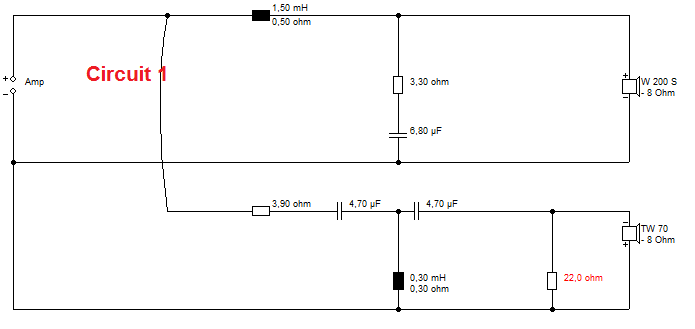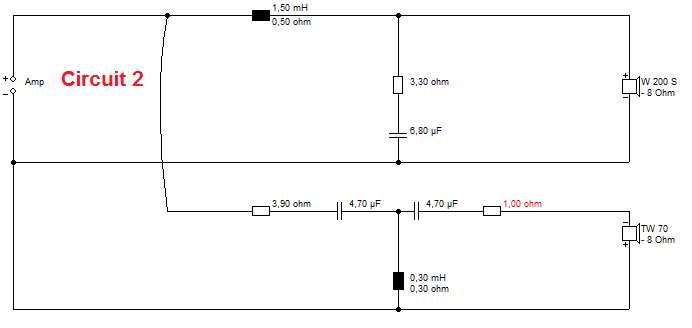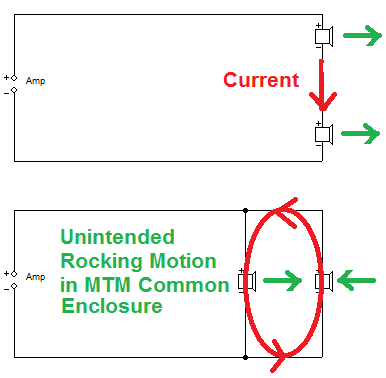I have clearly spelled out that something further needs to explain that an impedance can be dynamically changed by EMF that are motional, inductive and microphonic and that it affects negatively the V/I conversion that has to take place across the terminals of a loudspeaker.
Joe, I understand each and every word of this, but have no idea what you are saying. How can you expect people to take you seriously if you cannot explain yourself with some clarity? Maybe instead of all those 'shooting from the hip posts' you should just make a single one but try to tell us your thinking and reasoning? Surely this is no fun for you?
I am about to soon post a project of how to use high frequency bias in tube output transformers (a lapsed patent from the early 40's).
Good! Let me give you some free advice. If you post this as a fun project, using that patent, giving you all kinds of expertise and you end up with something that sounds not half bad, nobody will bother you except those genuinely interested.
But if, as I somehow suspect, this will be presented as the Rasmussen Bias project, claiming hitherto unknown quantum effects, you're in trouble. As you should be.
Jan
It is really sad as we are seeing a minority who have taken over DiyAudio and behind the scenes, speaking personally to some of the other Moderators, they are aware of this and sick of it. There are a LOT of upset people out there that will no longer contribute and they say it's about the trolling.
+1 🙁
Joe
Thanks for your reply. My question is about post #76, not#77. I quote
"Somebody here invoked Kirchoff's Law, but there are reasons why Kirchoff's Law doesn't quite work and is faced by things that make it fall apart in this instance."
Please explain why Kirchoff's law doesn't work. And when. Please, no hand waving.
Jay
Thanks for your reply. My question is about post #76, not#77. I quote
"Somebody here invoked Kirchoff's Law, but there are reasons why Kirchoff's Law doesn't quite work and is faced by things that make it fall apart in this instance."
Please explain why Kirchoff's law doesn't work. And when. Please, no hand waving.
Jay
Jay,
Joe replied, # 120.
OK when not satisfied with his answer, but repeating your question this way does not make much sense IMO.
Joe replied, # 120.
OK when not satisfied with his answer, but repeating your question this way does not make much sense IMO.
Joe replied, # 120.
Yes, he replied. No, he didn't answer. The question remains.
It's very simple - nobody is denying Kirchhoff's Law is for real and I believe clearly that I am being quoted out of context.
I have clearly spelled out that something further needs to explain that an impedance can be dynamically changed by EMF that are motional, inductive and microphonic and that it affects negatively the V/I conversion that has to take place across the terminals of a loudspeaker. That whole topic must take in a host of factors, one of which is KL, but KL in itself is not sufficient.
That is all.
My impression is that Joe needs some time to come up with something that might be interesting, or maybe not.
Just give him this time; the direction this discussion takes is not good.
Last edited by a moderator:
Good:But Steve, what you did was lowering the tweeter sensitivity wrt the rest of the system. Of course you heard a difference, duh!
There's no need to invoke a very unlikely 'transistor amps are sensitive to this' - it is a change in the speaker tonal response and you would hear it with ANY amplifier that has a reasonable flat response.
(Clearly if the amp falls off at 10kHz there's not much coming out of the tweeter and not much you can do at the tweeter).
Jan

Bad:

Jan, since you make yourself such an authority here, let me explain that what I hear with a circuit with a lowish ultrasonic impedance is an improvement in clarity, not a change in level.

I suggest a mechanism whereby an amplifier is sensitive to impedance. Take it or leave it, but I build it in these days.
Kirchoff's Law is violated in situations where there are induced currents or mechanical storage. Current flows without an emf. Hence this rocking motion might get overlooked by people who really don't think about what can happen in a speaker, here a parallel MTM:

Again, take it or leave it.
Pieter t
My question is about post 76. As SY stated the question wasn't answered. Joe's assertion that Kirchoff's law sometimes doesn't work means we have electrons vanishing or appearing at nodes/junctions in certain instances. I'd like to know how this happens explicitly. It's kind of important. IMO
Jay
My question is about post 76. As SY stated the question wasn't answered. Joe's assertion that Kirchoff's law sometimes doesn't work means we have electrons vanishing or appearing at nodes/junctions in certain instances. I'd like to know how this happens explicitly. It's kind of important. IMO
Jay
Kirchoff's Law is violated in situations where there are induced currents or mechanical storage. Current flows without an emf.
Again, take it or leave it.
Ah no, I think I'll leave it. The voltage and current loops still sum, where's the missing continuity? The current flows and the voltage sums to 0. This is Joe physics.
This is what Joe said in #76:
Maybe it had been better to state that there seems to be more to it than Kirchoff's Law. After all we are a bunch of smart guys being able to interprete what has been said huh? A bit of patience would help.
Somebody here invoked Kirchoff's Law, but there are reasons why Kirchoff's Law doesn't quite work and is faced by things that make it fall apart in this instance.
........... let me get back to you with what might be a somewhat lengthier reply (sorry), but it seems that it is needed. The dynamic properties of a moving coil driver are its own worst enemies and why something beyond KL is needed.
Maybe it had been better to state that there seems to be more to it than Kirchoff's Law. After all we are a bunch of smart guys being able to interprete what has been said huh? A bit of patience would help.
let me explain that what I hear with a circuit with a lowish ultrasonic impedance is an improvement in clarity, not a change in level.
I accept that you hear a difference, I already agreed to that. But the the two can and do sound pretty much the same. It is well known that an increase in treble is associated with more clarity.
But whatever the term, I think we agree on the effect as such.
Kirchoff's Law is violated in situations where there are induced currents or mechanical storage.
Wow! That's a clear statement so you must have a pretty good idea of the background. I wonder why they call it a 'law'? What then, pray tell, are the circumstances where it is no longer a 'law' and why?
Or is it an article of faith - which is fine but then say so please, we can all move on.
Jan
Wow, once again Joe suspends the laws of physics. Once again his followers blindly agree with something clearly beyond their understanding of the subject matter.
I don't see you getting your answer Jan. Your comment on post #119. I have the same problem with it that you do. "Clearly" is a word that is out of context in that post.
-Chris
I don't see you getting your answer Jan. Your comment on post #119. I have the same problem with it that you do. "Clearly" is a word that is out of context in that post.
-Chris
Hi Joe,
To break the constant circles that your threads tend to travel in, I suggest that maybe clear, well thought out answers that agree with the known universe be offered as answers.
-Chris
Did you research this? I believe there were/ was thread(s) on this topic. I do know that a product was also available to do exactly this. Introduce a high frequency "bias" to the signal in order to "jump" over the discontinuities around the zero signal point. So someone has already been there and done that on this topic. Want to pick another subject for your class project?I am about to soon post a project of how to use high frequency bias in tube output transformers (a lapsed patent from the early 40's).
I'm going to assume that you aren't referring to yourself as a repeat offender for this transgression. In that case, you are referring to those who ask questions without ever receiving a suitable response from you or yours. But there is no offense in posing a clear, calm and rational question when you are unclear, or you directly confront the laws of physics. You've got to expect questions when you cross those boundaries.The same pattern will repeat. The 'usual suspects' will turn up, find a phrase or word they can pick on and away we go again. Like I said, they have form on this and are repeat offenders.
To break the constant circles that your threads tend to travel in, I suggest that maybe clear, well thought out answers that agree with the known universe be offered as answers.
-Chris
Introduce a high frequency "bias" to the signal in order to "jump" over the discontinuities around the zero signal point.
Sounds like a cure for a problem that does not exist.
Hi Scott,
Yep.
I searched and got 2990 posts for "high frequency bias", but most were unintentional oscillators. But there was something on this topic, and either a kit or product sold to execute this idea.
This idea is really an AM transmitter of sorts with the carrier very low in relation to what you would normally see.
-Chris
Yep.
I searched and got 2990 posts for "high frequency bias", but most were unintentional oscillators. But there was something on this topic, and either a kit or product sold to execute this idea.
This idea is really an AM transmitter of sorts with the carrier very low in relation to what you would normally see.
-Chris
I don't want to give the impression that I just say 'no' when someone else says 'yes'. Kirchhoff's laws are so basic that to suggest that there are circumstances where they do not apply is a very, very tall claim.
For those not familiar: there are two laws, actually, a current law and a voltage law but they are conceptually the same. The voltage law says that if you go around in a circuit loop and measure and tally all voltages, you end up with exactly zero.
The current law say that if you measure and tally all currents entering and leaving a node, you end up with exactly zero.
There's no wiggle room. I can't imagining what it would be if, for instance, the total sum of currents in a node is some non-zero value. What will happen there - a heap of electrons? As I said, so basic that the laws can be traced all the way back to Maxwell's work, and conservation of energy. If you would have a violation, it would violate the conservation of energy and potentially open the door to a perpetuum mobile. You would have solved the worlds' energy problem and immeasurable riches will await you. And all that by fixing a crossover network! 😎
So how would that work again?
Jan
For those not familiar: there are two laws, actually, a current law and a voltage law but they are conceptually the same. The voltage law says that if you go around in a circuit loop and measure and tally all voltages, you end up with exactly zero.
The current law say that if you measure and tally all currents entering and leaving a node, you end up with exactly zero.
There's no wiggle room. I can't imagining what it would be if, for instance, the total sum of currents in a node is some non-zero value. What will happen there - a heap of electrons? As I said, so basic that the laws can be traced all the way back to Maxwell's work, and conservation of energy. If you would have a violation, it would violate the conservation of energy and potentially open the door to a perpetuum mobile. You would have solved the worlds' energy problem and immeasurable riches will await you. And all that by fixing a crossover network! 😎
So how would that work again?
Jan
Hi Scott,
Yep.
I searched and got 2990 posts for "high frequency bias", but most were unintentional oscillators. But there was something on this topic, and either a kit or product sold to execute this idea.
This idea is really an AM transmitter of sorts with the carrier very low in relation to what you would normally see.
-Chris
Hi-frequency bias was/is used a lot in tape recording to jump up and down the magnetic particles quantization, I think. My ancient AKAI had a 80kHz bias signal mixed in with the recording signal, possibly (not sure) even on a separate head.
Isn't it similar in concept to dither in digital processing?
Jan
I think that's where 'Joe's Law' comes into play, they go into the spare 'bucket o-electrons' sometimes referred to noise by folks in the know.There's no wiggle room. I can't imagining what it would be if, for instance, the total sum of currents in a node is some non-zero value. What will happen there - a heap of electrons? So how would that work again?
Jan
sheesh once again you guys miss the obvious!
I think that's where 'Joe's Law' comes into play, they go into the spare 'bucket o-electrons' sometimes referred to noise by folks in the know.
sheesh once again you guys miss the obvious!
Don't forget the ground side electrons.
Kirchhoff's laws are so basic that to suggest that there are circumstances where they do not apply is a very, very tall claim.
Where did Joe violate Kirchhoff's Law?
Please come up with evidence.
By the way please stay on topic (HF bias).
It looks like the old boys network is joining here; JC's thread is a better place.
- Status
- Not open for further replies.
- Home
- Loudspeakers
- Multi-Way
- Joe Rasmussen Usher S520 "Current Compatible" Crossover